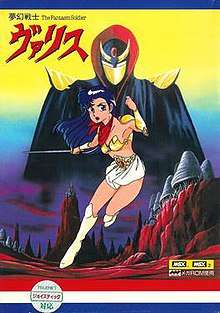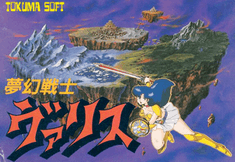Valis: The Fantasm Soldier
Valis: The Fantasm Soldier (夢幻戦士 ヴァリス, Mugen Senshi: Varisu, lit."Dream Soldier: Valis"), also known as either just Valis or The Fantasm Soldier, is a video game developed by Wolf Team and published by Telenet Japan in 1986 originally for the PC-88 and MSX home computers and then ported to, remade or re-released for several other systems over the years. It is the first video game in the Valis series which stars a Japanese teenager named Yuko who uses a mystical sword called Valis to defend Earth and other worlds. Its critical reception has varied depending on the version, including critical acclaim for the 1992 PC Engine remake.
| Valis: The Fantasm Soldier | |
|---|---|
 MSX cover art | |
| Developer(s) | Wolf Team Tokuma Soft (FC) Riot (MD/G, PCE) Bandai Namco Games (S) |
| Publisher(s) |
|
| Designer(s) | Hiroki Hayashi Yukio Mitsuhashi |
| Series | Valis |
| Platform(s) | PC-8801, MSX, X1, FM-7, PC-9801, Family Computer, Mega Drive/Genesis, PC Engine (Super CD-ROM²), Windows, S!Appli |
| Release | PC-8801, MSX, X1
|
| Genre(s) | Platform game Action RPG |
| Mode(s) | Single-player |
Gameplay
In its original PC-88 and MSX version, Valis: The Fantasm Soldier is a side-scrolling platform game. Wielding the game's titular sword, the main character fights through each level's enemies while jumping across ledges, then confronts a boss at the end of each level. At certain points in the game, gameplay pauses, and cinematic cutscenes regarding the game's storyline play. There is also a gameplay-tweaked and content-cut version for the FM-7.[1]
The Family Computer (Famicom) side-scrolling action role-playing game version of Valis differs considerably from the other versions of the game. While the basic plot remains the same, gameplay has moved from the linear stage design to larger maze-style levels with multiple paths, often of a questionable design, resulting in a very high difficulty level especially since there is neither a password nor a save system.[1]
The Mega Drive/Genesis remake features a gameplay system more similar to later games in the series, in particular Valis III. Like other side-scrolling games of the era, the four D-pad buttons move the character, and the three fire buttons perform three actions for the main character: sliding, jumping, and swinging her sword that can be upgraded in three stages and there are alternative firing modes. The player can also use magic spells, gaining them after defeating bosses.[2]
The PC Engine remake features improvements to the gameplay system (such as single high jumps instead of two-phase jumps and the sliding move damaging enemies) and voiced cutscenes.[2] The mobile remake further added new stages and alternate costumes.
Plot
Yuko Asou (麻生 優子, Asou Yūko) (voiced by Sumi Shimamoto) is a schoolgirl in late 1980s Japan who is fated to protect three different realms – our own Earth, the land of spirits, and Vecanti, the Dream World – by wielding a mystical sword known as Valis. Demon lord Rogles (ろぐれす, Roguresu) (voiced by Hideyuki Tanaka) extinguishes a light in Vecanti which functions as a source of power for those who live there, and in a desperate plea for salvation, its queen Valia ばりあ (Baria) (voiced by Yoshiko Sakakibara) reaches out for a brave soul who can help them in their time of despair. Yuko on Earth is the one who answers the call, being summoned by magical forces into Vecanti to liberate them from the evil of Rogles, who brainwashes Yūko's classmate Reiko Kirishima (きりしま 麗子, Kirishima Reiko) (voiced by Yūko Mita) into helping him try and put an end to the Valis warrior.
Against increasingly difficult odds, Yuko prevails. Although Reiko is killed in the process, her memory returns as she dies in Yuko's arms.[3]
Release

The original PC-88 and MSX were all developed by Wolf Team and published by Telenet Japan.[1] Tokuma Shoten would later develop and release an almost completely redone version for the Famicom in 1987 only in Japan.[1]
In 1991, Telenet and Renovation (United States) released versions for the Mega Drive/Genesis, developed by Riot.[2] An enhanced remake of the Mega Drive version was also developed by Riot and released by Telenet for the PC Engine's Super CD-ROM² add-on in 1992.[2] In 2005–2006, Bandai Namco released another remake of the game, this time for mobile phone platforms in Japan.[4]
Project EGG released various emulated versions of the game for Windows,[5][6][7][8] along with the compilation Complete Plus that came with a soundtrack CD and a figure.[9] The PC Engine version was released by Konami on the PlayStation Store in 2010,[10][11] and in 2014 was given for free for Japanese PlayStation Plus subscribers.[12]
Other media
A short promotional anime by Sunrise, directed by Hideaki Anno and Katsuhiko Nishijima, featuring music by Kohei Tanaka, was released in 1987 on the VHD attached to an issue of Anime Vision magazine. The artist PiXEL who was responsible for the game's character design also published three doujinshi books.[13] The orchestral arrangement of the game's soundtrack was released in 2011.[14] It is also one of the video games was adapted by Kouta Hirano into the manga titled Susume!! Seigaku Dennou Kenkyuubu (進め!!静学電脳研究部, Shiawase no katachi), published in the Gamest Comics collection in April 1999.
Reception
Sam Derboo from Hardcore Gaming 101 wrote the original versions "might be a horrible, unplayable mess, but its call to fame to begin with wasn't the gameplay, but the pioneering in cinematic cutscenes - two years even before Ninja Gaiden. (...) What's left is the quite excellent chiptune music, really the only part the original Valis is worth being remembered for."[1] Derboo further described the Family Computer version as a "typical Famicom action RPG - competently executed, but super obfuscate and endlessly frustrating."[1] Nevertheless, MSX Club "highly recommended" the MSX version as an "excellent" action game,[15] even as Arcades gave it a score of only 9/20.[16]
The Mega Drive / Genesis remake received rather mediocre but mostly positive review scores in the West, including 65% from Sega Visions,[17] 76% from Consoles+, 65% from Joystick, and 5/10 from ASM.[18] Hardcore Gaming 101's Derboo opined "Valis on the Genesis isn't a bad game, definitely leagues above the original, but still not particularly enjoyable. It's just so slow and boring."[2] Sega Force bashed its "dull and repetitive" gameplay and declared: "High graphical content, low playability level. That's Valis in a nutshell."[19]
On the other hand, the PC Engine / TurboGrafx version of Valis was acclaimed by critics. Its review scores included 81% from Consoles +,[20][21] 78% from Génération 4,[22] 77% from Joypad,[23][24] and 83% from Joystick.[25] According to Hardcore Gaming 101, "by its mechanics and level design, it is no doubt the most well-executed game in the entire series. It's still a bit too derivative and pedestrian to be counted among the genre greats like Castlevania and Ninja Gaiden, but at least very, very high second tier."[2] Retro Gamer highlighted it as "arguable the best" entry in a "great series".[26] Lucas M. Thomas from IGN included Valis among top ten unreleased TurboGrafx games: "If you're the kind of gamer who likes to know the exact color of panties being worn by your platforming hero girls, Valis is where you want to invest your time."[27]
Legacy
The game was followed by three sequels (Valis II, Valis III, Valis IV), an eroge spin-off Valis X, and two manga series.
References
- Derboo, Sam (2014-04-20). "Valis". Hardcore Gaming 101. Retrieved 2015-11-11.
- "Valis". Hardcore Gaming 101. Retrieved 2015-11-11.
- "MSX Force 1-12". Archive.org. Retrieved 2015-11-11.
- 家庭用ゲーム (2013-07-03). "バンダイネットワークス株式会社のプレスリリース | バンダイナムコエンターテインメント公式サイト". Bandainamcoent.co.jp. Retrieved 2015-11-11.
- "夢幻戦士ヴァリス / レトロゲーム総合配信サイト、プロジェクトEGG". Amusement-center.com. 2015-02-24. Retrieved 2015-11-11.
- "夢幻戦士ヴァリス / レトロゲーム総合配信サイト、プロジェクトEGG". Amusement-center.com. 2002-09-01. Retrieved 2015-11-11.
- "夢幻戦士ヴァリス / レトロゲーム総合配信サイト、プロジェクトEGG". Amusement-center.com. 2003-10-15. Retrieved 2015-11-11.
- "夢幻戦士ヴァリス / レトロゲーム総合配信サイト、プロジェクトEGG". Amusement-center.com. 2007-06-26. Retrieved 2015-11-11.
- "夢幻戦士ヴァリスCOMPLETE PLUS / レトロゲーム総合配信サイト、プロジェクトEGG". Amusement-center.com. Retrieved 2015-11-13.
- "夢幻戦士ヴァリス". Konami.jp. Retrieved 2015-11-11.
- "夢幻戦士ヴァリス | ソフトウェアカタログ | プレイステーション® オフィシャルサイト". Jp.playstation.com. Retrieved 2015-11-11.
- "PlayStation Plus Japan Has Earth Defense Force 2017 Portable, Valis, And Ys III As Freebies". Siliconera. 2014-05-02. Retrieved 2015-11-13.
- "我楽多展 - GA・RAKU・TA・TEN - 【トップ】". Park3.wakwak.com. Retrieved 2015-11-11.
- "― 「夢幻戦士ヴァリス」と「パワードリフト」のオリジナルサウンドトラックが発売". 4gamer.net. Retrieved 2015-11-11.
- "?MSXClub" (PDF). Scans.bytemaniacos.com. December 1988. Retrieved 2016-02-06.
- "King Knight" (JPG). Download.abandonware.org. Retrieved 2016-02-06.
- "Sega Visions Issue 08". Archive.org. Retrieved 2015-11-11.
- "Aktueller Software Markt - Ausgabe 1992/06". Archive.org. Retrieved 2015-11-11.
- Sega Force UK 5, page 76.
- "Super CD ROM Review" (JPG). Download.abandonware.org. Retrieved 2016-02-06.
- "Super CD ROM Review" (JPG). Download.abandonware.org. Retrieved 2016-02-06.
- "Console Test Review" (JPG). Download.abandonware.org. Retrieved 2016-02-06.
- "PC Engine Review" (JPG). Download.abandonware.org. Retrieved 2016-02-06.
- "PC Engine Review" (JPG). Download.abandonware.org. Retrieved 2016-02-06.
- "Valis : 83%" (JPG). Download.abandonware.org. Retrieved 2016-02-06.
- "Minority Report: Japanese warriors". Retro Gamer 129, page 45.
- "Retro Remix: Top 10 Unreleased TurboGrafx Titles - IGN - Page 3". Uk.ign.com. 2008-10-17. Retrieved 2015-11-11.